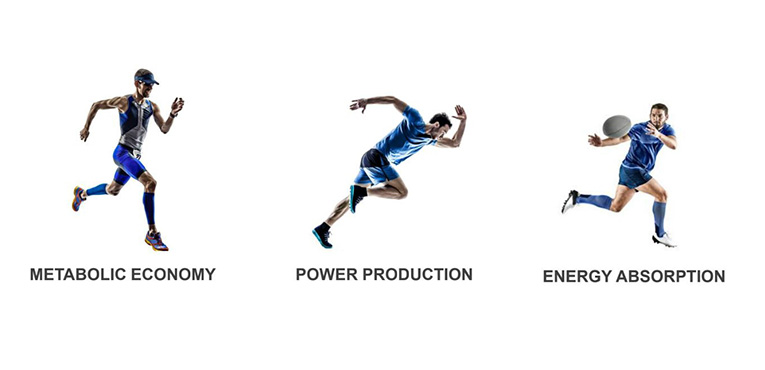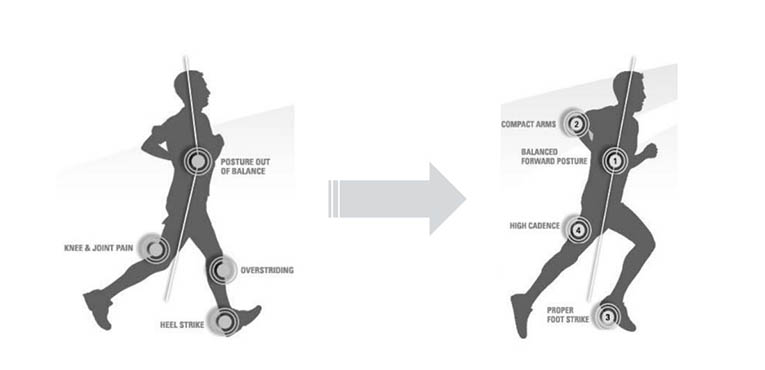Roberto Nicoletta - Technogym |
Dec.
18, 2018

HOW TO BENEFIT FROM CADENCE, CRITICAL POWER AND OTHER RUNNING METRICS
Running is one of those things that we take for granted, something that we have been doing for so long that we don’t really ever think about it. However, do we really know how to run? Are we really sure we do not need to learn how to run?
Running is an extremely complicated task that requires the conglomeration of different capacities: cardiovascular, neurological, psychological, physiological, anatomical, muscular and biomechanical. In this post, we will focus on the last three, trying to explain them in the clearest possible way.
Having the possibility of quantifying the effectiveness of the gesture performed and the accuracy of the workload through easily detectable metrics means training with quality and, if implemented with your workout routine, will surely bring enormous improvement to your running performance.
Simplifying the mechanics of running, we could describe it as a ball that bounces on the ground. The body’s bouncing motion on the feet allows us to store elastic energy and to use it in the following step (with considerable energy savings). It is therefore very similar to what happens in a spring; a biological spring!
However, how does this biological spring really work? It depends on the task:
- Are we looking for metabolic economy and energy saving (like when running or walking on flat ground)?
- Are we trying to amplify our power output (for example, when jumping, accelerating, incline running, etc.)?
- Or do we need to absorb forces (such as when landing, decelerating or decline running)?
If we are in the first scenario (energy saving), the body transmits its forces and momentum to the tendons, which
return most of that energy to the body itself in a cycle and repetitive motion. This means that our muscles need to do very little in order to keep the body moving.

This is not the case for the second scenario (power amplification), when higher power production is required. In fact, when accelerating, the muscles start the movement by transmitting the generated power to the tendons, which amplify it and transfer it in a greater fashion to the body.
The exact opposite is true for energy absorption: the body transfers all its energy to the tendons, which promptly carry it to the muscles capable of efficiently absorbing most of that energy1.
In every condition, there is always a seamless, finely coordinated mechanism between body, tendons and muscles.
The mechanics of proper running
In order for this mechanism to work efficiently, its components need to be perfectly aligned. It is exactly here that a proper running form becomes fundamental. From several biomechanical studies, it is known that a proper technique requires:
- compact arms
- balanced forward posture with the feet always falling under (or almost) the body’s center of mass
- good load distribution (symmetry)
- high cadence
- low ground contact times
- proper foot strike
So, next time you are out there running and struggling to maintain your pace at the 6th mile (~10th kilometer) of your run, you just need to make sure that all the aforementioned requirements are under control. Easy, right?! Well, not really; however, here’s where technology comes in handy.
Training indoors, on a device that can monitor all these parameters for you, returning a few clear, instant feedbacks, can no longer be seen as an alternative, but as an implementation that could actually improve the quality of your training and, ultimately, of your runs.
An insight into the ideal 5 parameters
At this point you might still be wondering why the aforementioned requirements are correlated with a good running form and how you can benefit from monitoring them. To clear these doubts, let’s analyze 5 metrics that should be taken into greater consideration and try to understand how to “play” with them.
- Contact Time. Experienced runners have low contact times2 (time that the foot spends on the ground), with sprinters averaging values between 110 and 150 milliseconds and distance runners between 170 and 350 milliseconds. The relationship between flight and contact time is called flight ratio and is greater in more efficient runners (with values ranging between 0, when walking, and about 50 percent).
- Stride and Cadence. Equally as important is monitoring your stride length and cadence. Runners with a short stride and high cadence have minor impact forces and consequently a lower incidence of injuries3. Moreover, a higher level of frequency “unlocks” those elastic properties mentioned earlier, allowing you to reduce oxygen consumption by about 20 percent and to increase running efficiency up to 50 percent4.
Be careful, though. There is no ideal stride or cadence, since these parameters can vary in relation to speed, acceleration and body type. That is why the best way to raise awareness of your cadence and turn it into a fatigue control system is to choose a speed, check your natural cadence at that given speed and train with cadence variations in a defined range between +5 percent and -5 percent.
- Symmetry is another value that is worth checking. Better load distribution between the right and left foot brings many advantages to both performance and preventive aspects, and it represents a parameter that can be monitored easily. Just remember that a range of variability of less than 5 percent is perfectly normal for healthy subjects and requires no intervention.
- Running power. We can describe running power output as how much force and speed a runner is exerting at any given moment. The power of our human engine should be equal to the sum of the power required to overcome running resistance, air resistance and climbing resistance (if present).
Therefore, speed (and consequently contact time), cadence (and so stride), body weight and its distribution (and therefore symmetry) all fall into the equation. Varying any of these will consequently vary our power output, making this parameter a sort of immediate and qualitative measure of our running form for a given task. For example, if your goal is endurance at a fixed constant speed, you want to keep lower values of power (which correlate with a better efficiency) while, if your aim is to accelerate and sprint, you want to produce the highest values of power possible.
Having the possibility of quantifying the effectiveness of the gesture performed and the accuracy of the workload through easily detectable metrics means training with quality and, if implemented with your workout routine, will surely bring enormous improvement to your running performance.
REFERENCES
1. Roberts TJ, Azizi E. Flexible mechanisms: the diverse roles of biological springs in vertebrate movement. J Exp Biol. 2011 Feb 1;214(Pt 3):353-61.
2. Hayes PR, Caplan N. Leg stiffness decreases during a run to exhaustion at speed at VO2max. Eur J Sport Sci. 2014; 14(6):556-62.
3. Lyght M, Nockerts M, Kernozek TW, Ragan R. Effects of foot strike and step frequency on Achilles tendon stress during running. J Appl Biomech. 2016; 32:365-72.
4. Cavagna GA, Saibene FP, Margaria RJ. Mechanical work in running. Appl. Physiol. 1964; 19:249-56.
Author: 
Roberto Nicoletta works in the Medical-Scientific Research & Innovation department of Technogym and holds the role of Head of Sport Science for the Italian Rugby League National Team. He also collaborated with the NBA as a Strength and Conditioning Coach during the NBA Global Camp 2018.
Roberto Nicoletta holds an international Master of Science in Sport Science, Health and Physical Activity obtained studying across 4 different European universities (the University of Foro Italico of Rome, the University of Southern Denmark in Odense, the German Sport University of Cologne and the University of Vienna).